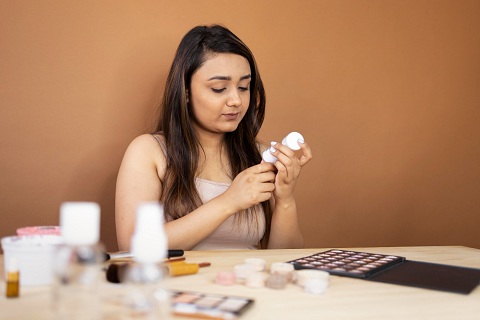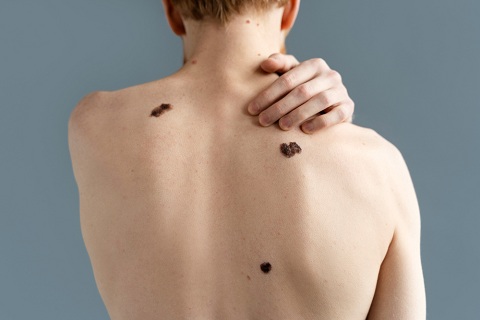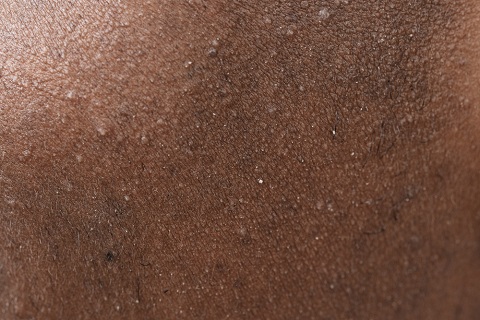Rosacea is a chronic skin condition that affects millions of people worldwide, characterized by facial redness, visible blood vessels, and sometimes, small, red bumps resembling acne. This article aims to provide a comprehensive overview of Rosacea Disease, including its causes, symptoms, diagnosis, natarul remedies, lifestyle management, and impact on daily life.
Rosacea is a common but often misunderstood skin disorder that primarily affects the face, particularly the cheeks, nose, chin, and forehead. It can manifest as persistent facial redness, visible blood vessels (telangiectasia), papules, and pustules. While the exact cause of rosacea remains unknown, various factors such as genetics, environmental triggers, and immune system responses are believed to contribute to its development.
Causes and Triggers of Rosacea
Rosacea can be triggered or exacerbated by factors such as sunlight exposure, hot or spicy foods, alcohol consumption, betel, stress, and certain skincare products. Individuals with fair skin, a family history of rosacea, or a tendency to blush easily are more susceptible to developing this condition.
Dyspepsia, menopause, amenorrhoea, emotional upsets, etc, but these are never the causative factors.
Symptoms and Types of Rosacea
The symptoms of rosacea can vary widely among individuals and may include facial flushing, persistent redness, visible blood vessels, acne-like bumps, and thickening of the skin. Rosacea is classified into several subtypes, including erythematotelangiectatic rosacea, papulopustular rosacea, phymatous rosacea, and ocular rosacea, each with its unique characteristics approach.
Rosacea is a chronic skin condition that typically affects the face, causing a range of symptoms that can vary in severity among individuals. The common symptoms of rosacea include:
- Facial Redness: Persistent redness, often resembling a blush or sunburn, particularly on the central part of the face, including the cheeks, nose, chin, and forehead.
- Visible Blood Vessels (Telangiectasia): Small, visible blood vessels (capillaries) on the surface of the skin, which can appear as red lines or patterns, especially on the cheeks and nose.
- Acne-like Bumps: Red, dome-shaped bumps or pustules that may resemble acne but are not associated with blackheads. These bumps can be tender and may contain pus.
- Flushing and Blushing: Sudden episodes of facial flushing or blushing, triggered by certain factors such as heat, spicy foods, alcohol, emotional stress, or sun exposure.
- Thickening of the Skin: In some cases, rosacea can lead to thickening of the skin, particularly on the nose (rhinophyma), resulting in a bulbous or enlarged appearance.
- Eye Irritation: Ocular rosacea can cause symptoms such as dryness, redness, burning, itching, and sensitivity to light (photophobia), affecting the eyes and eyelids.
- Sensitive Skin: Rosacea-prone skin is often sensitive and may react to skincare products, environmental factors, or temperature changes, leading to increased redness and irritation.
- Burning or Stinging Sensation: Some individuals with rosacea experience a burning or stinging sensation on the affected areas of the face, especially during flare-ups.
Diagnosis and Medical Examination for Rosacea
Diagnosing rosacea typically involves a thorough medical history review, physical examination of the skin, and in some cases, skin biopsies or laboratory tests to rule out other conditions. Dermatologists or healthcare providers experienced in treating skin disorders can accurately diagnose and determine the most suitable treatment plan for individuals with rosacea.
Lifestyle and Home Remedies for Managing Rosacea
In addition to medical treatments, adopting a gentle skincare routine, using non-irritating products, protecting the skin from sun exposure, managing stress, and avoiding triggers can help manage rosacea symptoms and prevent flare-ups. Cooling facial mists, gentle cleansers, and moisturizers with soothing ingredients like aloe vera or green tea extract can be beneficial for sensitive skin.
Coping with Emotional and Psychological Effects of Rosacea
Living with rosacea can have emotional and psychological impacts, including feelings of self-consciousness, embarrassment, and low self-esteem. Support groups, counseling, and education about rosacea can help individuals cope with the emotional challenges associated with this condition and improve their quality of life.
Prevention and Tips for Rosacea Management
While rosacea cannot be cured, preventive measures such as sun protection, avoiding triggers, maintaining a healthy lifestyle, and seeking early medical intervention can help manage symptoms and prevent complications. Regular follow-ups with healthcare providers are crucial for monitoring progress and adjusting treatment as needed.
Rosacea and Skincare Products: What to Avoid and What to Use
Choosing suitable skincare products is essential for individuals with rosacea. Avoiding harsh cleansers, abrasive scrubs, alcohol-based toners, and fragranced products can prevent irritation and minimize flare-ups. Instead, opt for gentle, non-comedogenic products formulated for sensitive skin and free from potential irritants.
Rosacea and Diet: Impact of Food Choices on Rosacea Symptoms
While specific foods may trigger rosacea flare-ups in some individuals, such as spicy foods, hot beverages, and alcohol, there is limited scientific evidence linking diet directly to rosacea development. However, maintaining a balanced diet rich in antioxidants, omega-3 fatty acids, and hydration can support overall skin health and reduce inflammation.
Rosacea and Sun Protection: Importance of Sunscreen and Protective Clothing
Sun exposure is a common trigger for rosacea symptoms, making sun protection crucial for individuals with this condition. Using broad-spectrum sunscreen, wearing hats, sunglasses, and seeking shade during peak sun hours can prevent sunburn, skin damage, and worsening of rosacea-related redness and inflammation.
Rosacea and Makeup: Tips for Applying Makeup with Rosacea

Choosing the right makeup products and application techniques can help conceal redness, even out skin tone, and enhance the natural beauty of individuals with rosacea. Opt for non-comedogenic, hypoallergenic makeup products labeled as suitable for sensitive skin, and use gentle blending techniques to avoid aggravating the skin.
It can be safe to undergo certain cosmetic procedures for rosacea treatment, but it’s crucial to consult with a qualified dermatologist or healthcare provider first. Treatments can help reduce redness, visible blood vessels, and other symptoms associated with rosacea. However, the safety and effectiveness of these procedures depend on factors such as the individual’s skin type, specific rosacea subtype, and overall health. A professional evaluation and personalized treatment plan are essential to ensure the safety and optimal results of cosmetic procedures for rosacea.
Impact of Rosacea on Quality of Life and Social Interactions
Rosacea can impact various aspects of daily life, including social interactions, work-related activities, and self-image. Educating others about rosacea, seeking support from loved ones, and focusing on self-care can empower individuals with rosacea to navigate challenges, maintain confidence, and enjoy fulfilling social connections.
Natural remedies that can help with rosacea
Certainly! While there is no cure for rosacea, some natural remedies and lifestyle modifications may help manage symptoms and reduce flare-ups. It’s important to note that these remedies may vary in effectiveness for different individuals, and consulting with a healthcare provider is recommended before trying any new treatment approach. Here are some natural remedies that may help with rosacea:
- Green Tea: Green tea contains antioxidants and anti-inflammatory properties that can help soothe irritated skin. Applying cooled green tea bags or using skincare products containing green tea extract may provide relief for some individuals with rosacea.
- Licorice Extract: Licorice extract has been found to have anti-inflammatory effects and may help reduce redness and inflammation associated with rosacea. Look for skincare products formulated with licorice extract or consult with a dermatologist for guidance.
- Chamomile: Chamomile has calming and anti-inflammatory properties that can benefit sensitive skin. Using chamomile-based creams or applying cooled chamomile tea compresses may help alleviate redness and discomfort caused by rosacea.
- Oatmeal: Oatmeal has soothing properties and can help relieve itching and irritation associated with rosacea. Taking oatmeal baths or using skincare products containing colloidal oatmeal can be beneficial for managing symptoms.
- Probiotics: Probiotics, either through dietary supplements or fermented foods like yogurt, kimchi, and sauerkraut, may support gut health and immune function, potentially reducing inflammation and improving skin condition in some individuals with rosacea.
- Aloe Vera: Aloe vera gel has moisturizing and anti-inflammatory properties, making it a popular natural remedy for various skin conditions, including rosacea. Applying pure aloe vera gel to affected areas can help soothe redness and irritation.
- Omega-3 Fatty Acids: Consuming foods rich in omega-3 fatty acids, such as fatty fish (salmon, mackerel, sardines), flaxseeds, and walnuts, may have anti-inflammatory effects that could benefit individuals with rosacea. Consult with a healthcare provider before starting any new dietary supplements.
- Avoiding Triggers: Identifying and avoiding triggers that worsen rosacea symptoms, such as spicy foods, hot beverages, alcohol, sun exposure, harsh skincare products, and extreme temperatures, is essential for managing the condition naturally.
Here are the answers to your FAQs about rosacea:
Clearing rosacea involves a combination of medical treatments, lifestyle modifications, and skincare routines tailored to individual needs. Dermatologists may prescribe topical medications, oral antibiotics, laser therapy, or other treatments to manage symptoms and reduce redness. Avoiding triggers, using gentle skincare products, protecting the skin from sun exposure, and managing stress can also help clear rosacea and prevent flare-ups.
While rosacea is not life-threatening, it can significantly impact quality of life due to its visible symptoms and potential effects on self-esteem and emotional well-being. Rosacea may also lead to complications such as eye problems (ocular rosacea) or thickening of the skin (rhinophyma) in some cases. Early diagnosis and appropriate management can help prevent complications and improve outcomes.
Rosacea is a chronic condition that typically does not go away on its own. However, symptoms can vary in severity and may improve or worsen over time. With proper treatment and lifestyle management, many individuals can effectively manage rosacea and experience periods of remission with fewer flare-ups.
While there is no permanent cure for rosacea, various treatments can help manage symptoms and reduce redness effectively. Consistent use of prescribed medications, lifestyle modifications, and ongoing skincare routines can control rosacea and improve skin appearance. It’s essential to work with a dermatologist to develop a long-term management plan.
Rosacea can present with different symptoms and appearances, including persistent facial redness, visible blood vessels (telangiectasia), acne-like bumps (papules and pustules), and thickening of the skin, especially on the nose (rhinophyma). Flushing episodes, sensitivity to skincare products, and eye irritation (ocular rosacea) are also common features of rosacea.
Applying ice or cool compresses can temporarily reduce redness and soothe inflamed skin in individuals with rosacea. However, it’s essential to use ice packs or cold compresses gently and avoid prolonged exposure to extreme cold, as it can potentially irritate sensitive skin. Consult with a dermatologist for personalized advice on managing redness and inflammation associated with rosacea.
Conclusion
Rosacea Disease is a complex skin condition that requires a multifaceted approach to management, including natarual treatment, lifestyle modifications, and emotional support. By understanding the causes, triggers, symptoms, and effective strategies for rosacea management, individuals can take proactive steps to minimize symptoms, improve skin health, and enhance overall well-being.





